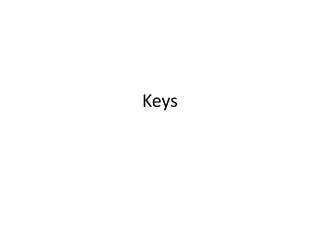Understanding Dichotomous Keys in Biology
A dichotomous key is an essential tool for biologists to identify plants and animals based on specific characteristics. This key methodically presents pairs of contrasting descriptions to guide the user towards accurate identification. Through visual and descriptive examples, the concept of dichotomous keys is explained, highlighting their practical application in classification and categorization within the biological sciences.
Download Presentation

Please find below an Image/Link to download the presentation.
The content on the website is provided AS IS for your information and personal use only. It may not be sold, licensed, or shared on other websites without obtaining consent from the author. Download presentation by click this link. If you encounter any issues during the download, it is possible that the publisher has removed the file from their server.
E N D
Presentation Transcript
DICHOTOMOUS KEYS
WHAT IS A DICHOTOMOUS KEY? When a biologist wants to identify a plant or animal they have found, they often use an identification key which contains the major characteristics of groups of organisms. A dichotomous key is one type of identification key. The term dichotomous means "divided into two parts or categories . Dichotomous keys are constructed of pairs of descriptions that contrast two categories of a characteristic such as size or color. After each category description, the key either directs the user to another pair of descriptions or identifies the plant or animal.
DESCRIPTIVE DICHOTOMOUS KEY 1. Adult is <30 lbs 1. Adult is >30 lbs 2. Legs are longer than arms 2. Legs are not longer than arms Go to 3 3. Fur is orange/red 3. Fur is not orange/red 4. Adult is <150 lbs 4. Adult is >150 lbs Gibbon Go to 2 Human Orangutan 4 Chimpanzee Gorilla
SHOE KEY Everyone should take off one shoe and place it in the center of the table. As a group, divide the shoes on the table into two piles that differ in some obvious characteristic that distinguishes the shoes in one pile from the shoes in the other pile. (The piles do not have to have exactly equal numbers of shoes.) After you agree on the distinguishing characteristic, record the two categories of the distinguishing characteristic on the first two horizontal lines on the chart on page 3.
SHOE KEY Push one pile of shoes to the side. For the other pile, choose a second distinguishing characteristic to divide this pile into two distinct piles. Record the categories of the second distinguishing characteristic on the chart. Continue the procedure of dividing the shoes into two distinct piles and adding the information to the chart until you reach a category that has only one shoe. This shoe is now identified; add the owner s name to the chart. Continue until each shoe in the first pile has been identified and entered in the chart.
SHOE KEY Divide the second pile of shoes in the same manner as the first pile until all the shoes have been identified.
SHOE KEY Dichotomous keys usually appear in an equivalent, more compact list form, as shown on the bottom of page 1. The shoe chart you constructed can be easily converted by adding numbers to the fork of each characteristic used and creating a list of description pairs. Label the chart in numerical sequence following the same order the characteristics were written down. In the space provided on page 4, create a list dichotomous key for the shoes.
SHOE KEY Push all the shoes back together in one pile. Grab a shoe randomly from the pile. Use the key to identify who the shoe belongs to and return it to its owner.
SHOE KEY Obtain a shoe from another group. Try to identify who s shoe it is using the key you created. Can you correctly identify an item that was not used in a key s original construction? Why is this so? There are more than 90,000 species of insect in the United States. Do you think it would be more difficult to create a dichotomous key for all the insects in the United States than it was for the shoes in your group? Why do you think so? Do you think it is important to be able to identify all the insects in the United States? Why or why not?























